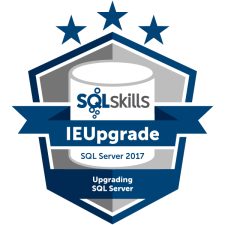(Retired – no longer offered as a public class)
Overview
This 3/400-level, 3-day, SQL Server training class is designed to help you justify, plan and implement a successful upgrade and migration from a legacy version of SQL Server (SQL Server 2005 or newer), to a currently supported version of SQL Server (SQL Server 2012 or newer).
This class will give you a wealth of practical techniques that you can use as soon as you return to work. We will cover license, feature, and performance differences between SQL Server 2016 Standard Edition and SQL Server 2016 Enterprise Edition. We give you extremely useful information about new features in SQL Server 2012-2017 to help you make the technical and business case for an upgrade.
We will have detailed information about how to select and configure your hardware and storage to maximize your performance and minimize your SQL Server license costs, whether it is deployed bare-metal on-premises, virtualized on-premises, or in a Windows Azure VM (IaaS).
We will cover how to properly install and configure SQL Server 2016 for the best performance and reliability. We will also demonstrate how to use the Microsoft Data Migration Assistant and the Microsoft Database Experimentation Assistant to help discover issues that could prevent a successful upgrade and migration.
There will also be extensive coverage of how to plan and implement a successful production migration with minimal downtime and no data loss.
All these topics will be addressed on multiple fronts: with planning and implementation considerations and techniques, common problems, troubleshooting, and multiple demonstrations.
Our aim is that you can apply what we teach you to any upgrade and migration situation and justify your solution to your peers, management, or clients (yes, we welcome SQL Server consultants in our classes).
This course is useful and relevant regardless of whether you have attended any other SQLskills IE courses or not.
This course will cover SQL Server 2005 through SQL Server 2017, and is essential for all SQL Server DBAs, and architects. We will answer all your questions, to whatever depth you want to go.
Instructors: Glenn Berry and Tim Radney
Need Help Justifying Training? Here’s a letter to your boss explaining why SQLskills training is worthwhile and a list of community blog posts about our classes.
Curriculum
Module 1: Upgrade Planning
Understanding the technical and business benefits of an upgrade to a newer version of SQL Server are a critical part of making a compelling case for an upgrade. Topics covered include:
- License differences between Standard and Enterprise
- Feature differences between Standard and Enterprise
- Performance differences between Standard and Enterprise
- Making the case for an upgrade
- What’s new in SQL Server 2012
- What’s new in SQL Server 2014
- What’s new in SQL Server 2016
- What’s new in SQL Server vNext
Module 2: Hardware and Storage Selection and Configuration
Understanding how to properly select hardware to get the best performance possible, while also minimizing your SQL Server license costs is an important part of the upgrade process. After you have selected your hardware, making sure it is properly configured is vital for the best performance and scalability. Also, selecting the right type of storage and making sure it is configured and tested properly is also very important (and often ignored). Topics covered include:
- Choosing hardware to minimize licensing costs
- Choosing hardware to enable consolidation or virtualization
- Choosing storage to meet your architecture and performance requirements
- Properly configuring your hardware and storage
- Testing and benchmarking your hardware and storage
Module 3: SQL Server 2016 Installation and Configuration
SQL Server 2016 is deceptively simple to install, yet a default installation has a number of issues that can reduce your performance and reliability. Knowing what needs to be changed and how to do it as part of your standard provisioning process is very useful. Topics covered include:
- GUI installation
- Unattended installation
- The SQL Server Basic Installer
- SSMS Installation and Maintenance
- Updating SQL Server
- Best practice configuration settings
Module 4: Upgrade Testing
Testing your databases for an upgrade is critical to having a successful migration. You need to test for compatibility, user acceptance, performance impacts and more. Topics covered include:
- Microsoft Data Migration Assistant
- Application testing methods
- Checking for performance regressions due to the new cardinality estimator
- Alleviating performance regressions
- Working with other teams during testing
- The wisdom of not upgrading in place
Module 5: Migration Planning
Preparing your existing databases for the upgrade and migration process will make the migration go more smoothly and more quickly. There are a number of preparation items that can be done before the migration to help with this effort. Topics covered include:
- Important preparation work before migration
- Index maintenance
- Backup compression
- Striped backups
- Migrating instance-level objects
Module 6: Migration Testing
There is much more that should go into upgrading a database than just a backup and restore to a new version of SQL Server. When it comes time to do the actual migration, you likely will need to minimize the downtime. Topics covered include:
- Microsoft Database Experimentation Assistant
- Migration methods
- Migrating users
- Migrating SQL Agent Jobs
- Migrating SSIS
Module 7: Production Migration Methods
The final step of an upgrade and migration to a new version of SQL Server is actually moving your production data to the new instance and switching over to using that new instance with no data loss and the shortest outage possible. Topics covered include:
- Upgrade in place
- Side-by-side installation
- Attach/detach
- Backup/restore
- Using log shipping
- Using database mirroring
- Post migration tasks
- Post migration monitoring
Questions?
If you have any questions not answered by our F.A.Q., please contact us.

